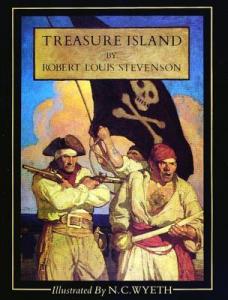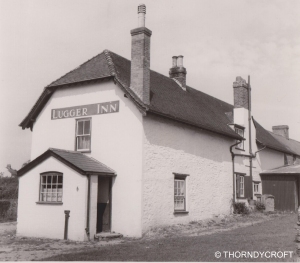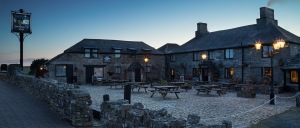There's something about a good pub scene in an English historical novel that strikes a cosy chord with most readers. Perhaps it is because England's old inns and coaching houses have remained largely unchanged through the ages that the atmosphere is instantly identifiable. The low, smoke-stained ceilings, the glint of light on dark bottles, the smell of home cooked food and the crackle of the open hearth are recognisable to just about every English person and have been so for centuries. This post will take a look at several inns in historical novels and their real life inspirations.
The Why Not

From: Moonfleet by J. M. Falkner
Based on: The Lugger Inn (Chickerell, Weymouth)
The Why Not lies at the bottom of J. M Falkner's fictional village of Moonfleet. It's real name is the Mohune Arms. The Mohunes were once a powerful family that owned all of Moonfleet, but have since fallen into ruin. Their shield is white with a black 'Y' (in fact a cross-pall) which inspires the humorous local name of the inn where young hero John Trenchard comes to live after being thrown out by his stern old aunt. The owner of the Why Not is Elzevir Block, a shady character at odds with the local Customs Officers and John Trenchard quickly learns about the mysterious nighttime activities of his new master.
"On singing nights the room grew hot, and the steam stood so thick on the glass inside that one could not see in; but at other times, when there was no company, I have peeped through the red curtains and watched Elzevir Block and Ratsey playing backgammon at the trestle table by the fire."
The Why Not is widely believed to have been based on the Lugger Inn at Chickerell, Weymouth. The photo on the right is an old family picture (my dad used to live nearby) from about 1959. It has been extensively expanded in recent years.
You can visit its website here.
The Admiral Benbow
Any number of inns on the North Devon and Somerset coast could have inspired the home of Jim Hawkins and his recently widowed mother. This is the 'handy cove' that retired buccaneer Billy Bones washes up in before drinking himself to death and leaving young Jim in the possession of a treasure map to pirate gold.You can visit its website here.
The Admiral Benbow
"The man who came with the barrow told us the mail had set him down the morning before at the Royal George, that he had inquired what inns there were along the coast, and hearing ours well spoken of, I suppose, and described as lonely, had chosen it from the others for his place of residence."
 While the inn itself may not be based on any real establishment, its namesake was certainly a real fellow.
While the inn itself may not be based on any real establishment, its namesake was certainly a real fellow.Admiral John Benbow is something of a naval legend. Born in 1653, he entered the navy at 25 and fought Barbary pirates before becoming a merchant trader. He again encountered pirates (reportedly cutting off the heads of his Moorish attackers, salting them and taking them to Spain for a reward).
Benbow returned to the navy in 1689 and took part in bomb flotillas against France. His fearlessness (which his peers often disputed) earned him a promotion to admiral and his commission in the Caribbean saw perhaps his greatest exploit.
Spotting several French ships off Santa Marta in 1702, Benbow pursued them for five days while four of his captains lagged behind (earning two of them court martials and executions). His leg shattered by French fire, Admiral Benbow remained on deck but later died of his wounds in Jamaica.
His courageous exploits earned him fame and three ships of the Royal Navy have been named HMS Benbow in his honour as well as the shanty 'Brave Benbow' which you can listen to here.
The Spyglass
 |
Based on: The Llandoger Trow (Bristol)
For a novel about pirate treasure buried on a desert island, there are a large amount of English pub scenes in Treasure Island. The second inn from that novel is the Bristol tavern and place of business for the wily seacook Long John Silver.
"It was a bright enough little place of entertainment. The sign was newly painted; the windows had neat red curtains; the floor was cleanly sanded. There was a street on each side and an open door on both, which made large, low room pretty clear to see in, in spite of clouds of tobacco smoke."
 |
| Source: Swamp Dragon |
It was built as early as 1664, its name coming from the flat-bottomed barges that came across the Severn Estuary from the Welsh village of Llandogo. Only three of its five original gables remain, the other two being bombed during the Second World War.
Robert Louis Stevenson wasn't the only writer who knew those low ceilings and black beams. Robinson Crusoe author Daniel Defoe allegedly met Alexander Selkirk there - the real life castaway who inspired the novel. The Llandoger Trow now trades as a Brewers Fayre and you can visit their website here.
Jamaica Inn
 From: Jamaica Inn by Daphne du Maurier
From: Jamaica Inn by Daphne du Maurier Based on: Jamaica Inn (Bodmin Moor, Cornwall)
Although set in 1820, du Maurier's gothic romance features a real inn built in 1750 which has since become a tourist attraction. The lonely, windswept inn on Bodmin Moor receives orphaned farm girl Mary Yellan, come to live with her aunt; the long-suffering Patience. Patience's husband, Joss Merlyn is the owner of the inn and a gargantuan monster of a man with a violent temper. By falling in with Joss's younger brother, Jem, Mary learns the sinister truth behind Jamaica Inn and its odious owner.
"She could see tall chimneys, murky dim in the darkness. There was no other house, no other cottage. If this was Jamaica, it stood alone in glory, four-square to the winds."
Jamaica Inn allegedly derives its name from the nearby Trelawney family (take note, Treasure Island fans), of which two members were governors of Jamaica. It was extended into a coach house in 1778.
Cornwall and Devon were rife with smuggling in the 18th century and Jamaica Inn has more than its share of legends concerning smugglers and wreckers that inspired du Maurier's novel. Due to the novel's success and the resulting Hitchcock film, the inn is now a popular tourist attraction and even has a smuggling museum attached.
You can take a look here. In another literary link, author Alistair MacLean owned the inn in the early seventies.
The White Hart
 |
| The Rebel and the Runaway |
Based on: The White Hart (Rowlands Castle, Hampshire)
A bit cheeky, including one from my own novel, but there you go.
The White Hart is the inn that the protagonist Alice Sinclair takes up work in after running away from home. On the border between Hampshire and West Sussex, the White Hart is a meeting point for members of the Hawkhurst Gang; the most feared and violent gang of smugglers in all England.
Dark events unfold in the autumn of 1748 when revenue officer William Galley and his charge, Daniel Chater (a witness he is escorting to trial to testify against the smugglers), stop by the White Hart for refreshment. Alice watches in horror as the two men are plied with drink and spirited off into the night, never to be heard from again.
"The common room had a low ceiling stained with tobacco smoke. Rows of mugs, jugs and bottles were lined up on the other side of a vast oak bar the surface of which was greatly marked and stained. A huge fireplace dominated the far side of the room and the wall above it was decorated with a variety of villainous looking implements; pistols, pikes and rusty farming tools. The chairs and tables that dotted the room were rough, crude and mismatched."
 The White Hart is mentioned in several contemporary sources pertaining to the murders of Galley and Chater.
The White Hart is mentioned in several contemporary sources pertaining to the murders of Galley and Chater.Little further is known about it as the inn was torn down around 1859 to make room for the railway. A new inn was constructed on the site (purportedly using the same materials) and still stands today as the Castle Inn. Visit it here.
~~~~~~~~~~~~~
Chris Thorndycroft is the author of The Rebel and the Runaway as well as the Hengest and Horsa Trilogy and the ghost story novella The Visitor at Anningley Hall (a prequel to M. R. James’s ‘The Mezzotint’). He also writes Steampunk and Retropulp under the pseudonym P. J. Thorndyke.



I never realized until now how many of my favourite books feature inns! Love Moonfleet and Jamaica Inn. Great post!
ReplyDeleteExcellent post, I will reference it at the historical fiction workshop I'm presenting next month in Golden Colorado (Rocky Mountain Fiction Writers Genre Fest.)
ReplyDeleteInteresting post. I love reading about English Inns, and two of my favorite adventure novels were Jamaica Inn and Treasure Island. Interesting connection re: the Trelawney family.
ReplyDeleteWhat a great subject for a blog post. I used to sit in the garden of the Mohune Arms aged 10 when my Mum and Dad drove there in 1961. It was the middle of my Dad's driving lesson!
ReplyDelete